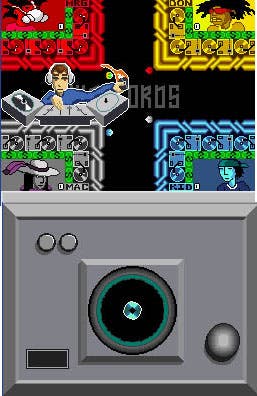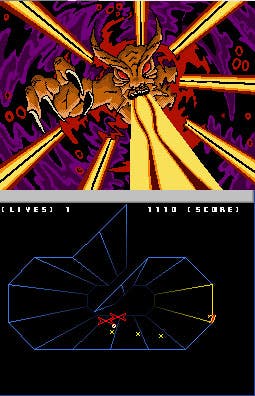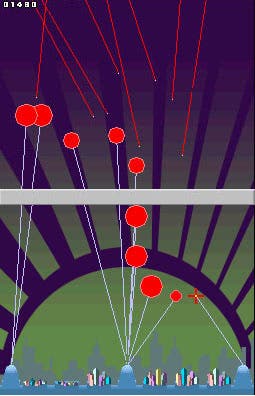Retro Atari Classics
Old arcade games are now officially a touchy subject.
Retro compilations have almost become a retro concept in themselves at this point. Don't believe me? It's ten long years since I bought the exciting-sounding Williams Arcade Classics compilation (before I'd even acquired a PlayStation, it's that long ago) and began the long, drawn out process of dismantling my bespectacled rose-tinted view of how good old games were.
Am I at the end of my tether on the subject yet? Well, not quite. We were all quite appalled by the whole Classic NES Series debacle in terms of being a breathtaking example of mean spirited and misguided daylight robbery, yet reasonably happy with how Atari threw in 85 games for its recently issued Anthology Volume 1 compilation. We're still in love with the past no matter how much it reminds us how old we're getting. It can insult us all it likes by choosing to mess with our recollections and embarrass us in public like a rowdy incontinent pensioner, but it's not going to break our spirit. But we might not want to sponsor its dubious activities, however much it makes eyes at us with its face pressed up against the glass.
Touch and go

Case in point: Retro Atari Classics. On the surface it's a straight-up ten-game pack of some of Atari's best-loved arcade hits of the 70s and early 80s. But dig a little deeper and it's a collection that tries to 'remix' each game as well make use of the touch pad - but with varying degrees of success. It sounded promising; it felt lightweight.
With some bona-fide seminal classics here such as Pong, Breakout, Tempest, Asteroids and Missile Command on here there's a few to get nostalgists weeping for joy as they simultaneously take a step into the future and the past at the same time. It's an interesting crossover.
Indeed, the precision controls afforded by the touch screen finally allow gamers to experience games in a way that they haven't been able to since they were first released. With many games back then requiring all sorts of odd bespoke controllers such as paddles and trackballs it was always going to be impossible to replicate these analogue controls satisfactorily - until now.
Bringing precision to the past

The touch screen input on games such as Pong, Breakout, Missile Command, and to a lesser extent Centipede, Warlord and Tempest makes these precision games an absolute joy to play, giving you total control over where to position yourself. On others, though, it's just not well suited to the demands of these ancient relics, and games like Sprint, Asteroids, Gravitar and Lunar Lander feel clumsy and unplayable using the touch screen. Just as well, then, that the standard digital controls are well suited to these - in almost a mirror image of the games which work well on the touch screen.
The novelty value of gracefully gliding a stylus across the screen to guide your Pong or Breakout bat around with pace and precision, or zapping the incoming missiles in Missile Command with a tap of the screen in the exact space you want it in, is genuinely high - but are many of these games even that compelling these days? For the sake of filling in a quick five minutes here and there then some of them still have that pick-up-and-play quality that will never die, but...
Others, though, just feel like bizarre choices given Atari's bursting back catalogue. Why on earth include black and white top down racing game Sprint rather than the vastly superior Super Sprint? Both Gravitar and Lunar Lander are an acquired taste, being hard to categorise inertia/gravity-based space games of some repute at the time, but now just feel like frustrating experiments; museum pieces, not pick up and play games to show off on a new console two and a half decades later.
War. Lords. What are they good for?

Warlords is another curiosity - but in a good sense - being a refreshing four player take on the whole breakout theme, except each player must defend their own 'castle' from a deadly fireball that you deflect between each other with your warlord. But as good as it still is in single-player mode even now, the huge potential enjoyment to be gleaned out of four player wireless retro action is ruined by Atari's hard-faced instance on making this a multi-card multiplayer experience.
This tight-fisted approach to life on the DS also scuppers any thoughts of multiplayer Pong or Sprint, and strikes us as a real missed opportunity. Say "no" to multi-card multiplayer modes, and "yes" to actually giving users an incentive to buy your games!
The main incentive, as far as I can see, to buying Retro Atari Classics is the chance to get some pick-up-and-play classics that you know and love for a new portable console with some cool USPs. What I fail to see is any incentive to play any of the so-called "Remix" versions of all ten games, which essentially replace the original graphics with hideous graffiti-strewn abominations that attempt to lend the package some sort of misguided street cool. They don't. It looks like my nephew got a bit overenthusiastic with Paint Shop Pro, designed some 'hilarious' characters and got paid for it. The gameplay is identical, so it's quite hard to understand what the whole point is - other than to annoy old gits like me who don't like people messing around with the original vision and make teenagers snigger at how rubbish it all looks. Honestly. It'd be like remaking Star Wars with the So Solid Crew, innit?
I can't believe it's not er, better
Now that I've made the successful transformation from winsome retro kid into ranting Victor Meldrew, there's little more to say about Retro Atari Classics other than it's your veritable cast iron "mixed bag" of timeless gems and pointless curios in which some work well on the DS, some don't and as long as you can deny all knowledge of seeing the Remix mode retro gamers won't be totally offended. They might expect to pay a little less than the asking price, though, and might reasonably expect that the next publisher to try this trick will throw a whole lot more than a mere 10 games in order to extract the folding stuff from our wallets.

